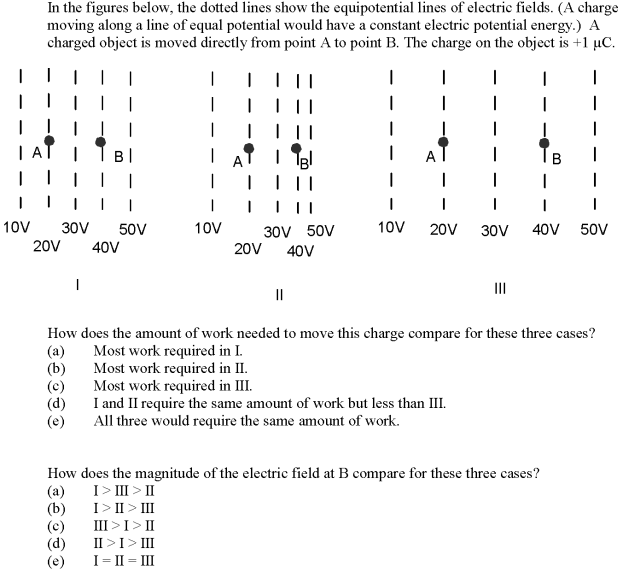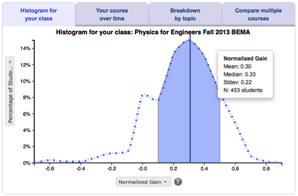Developed by David Maloney, Alan van Heuvelen, Curtis Hieggelke, and Thomas O'Kuma
| Purpose | To assess students’ knowledge about topics in introductory electricity and magnetism. |
|---|---|
| Format | Pre/post, Multiple-choice |
| Duration | 50 min |
| Focus | Electricity / Magnetism Content knowledge (electrostatics, magnetic fields and forces, Faraday's law) |
| Level | Intro college |
Sample questions from the CSEM:

CSEM Implementation and Troubleshooting Guide
Everything you need to know about implementing the CSEM in your class.
Login or register to download the implementation guide.
more details
This is the second highest level of research validation, corresponding to at least 5 of the validation categories below.
Research Validation Summary
Based on Research Into:
- Student thinking
Studied Using:
- Student interviews
- Expert review
- Appropriate statistical analysis
Research Conducted:
- At multiple institutions
- By multiple research groups
- Peer-reviewed publication
The multiple-choice questions on the CSEM were developed using students’ explanations for their responses on both open-ended and multiple-choice versions of the questions, expert review (100+ physics instructors) and analyzing large sets of test data (from over 5000 students at over 30 institutions including two-year and four-year colleges, and universities). Appropriate statistical analyses of difficulty, discrimination and reliability were performed. The CSEM questions have a reasonable range of difficulties and most questions are able to satisfactorily distinguish students who know the material well from those who don’t. The overall reliability of the CSEM is good. A factor analysis was performed, but no strong factors were identified. The CSEM has been used to compare the effectiveness of different teaching methods and the results published in over 15 peer-reviewed publications. It has been administered at many different institutions.
References
- M. Brundage, Investigating and Improving Student Understanding of Mechanics, Electricity and Magnetism, Quantum Mechanics, and Thermodynamics using Conceptual Surveys, Ph.D. Dissertation, University of Pittsburgh, 2024.
- D. Demaree and Y. Lin, Assessing ISLE Labs as an Enhancement to Traditional Large-Lecture Courses at the Ohio State University, presented at the Physics Education Research Conference 2005, Salt Lake City, Utah, 2005.
- L. DeSilva, A. Pullen, and J. Hasbun, Enhancing student performance in introductory physics in topics related to electricity and magnetism through the use of voluntary workshops, Eur. J. Phys. 39 (3), 035702 (2018).
- S. DeVore, J. Stewart, and G. Stewart, Examining the effects of testwiseness in conceptual physics evaluations, Phys. Rev. Phys. Educ. Res. 12 (2), 020138 (2016).
- K. Diff and N. Tache, From FCI To CSEM To Lawson Test: A Report On Data Collected At A Community College, presented at the Physics Education Research Conference 2007, Greensboro, NC, 2007.
- L. Ding, N. Reay, A. Lee, and L. Bao, Effects of testing conditions on conceptual survey results, Phys. Rev. ST Phys. Educ. Res. 4 (1), 010112 (2008).
- J. Dowd, Interpreting Assessments of Student Learning in the Introductory Physics Classroom and Laboratory, Ph.D., Harvard University, 2012.
- P. Eaton, B. Frank, K. Johnson, and S. Willoughby, Comparing exploratory factor models of the Brief Electricity and Magnetism Assessment and the Conceptual Survey of Electricity and Magnetism, Phys. Rev. Phys. Educ. Res. 15 (2), 020133 (2019).
- P. Eaton, K. Johnson, B. Frank, and S. Willoughby, Classical test theory and item response theory comparison of the brief electricity and magnetism assessment and the conceptual survey of electricity and magnetism, Phys. Rev. Phys. Educ. Res. 15 (1), 010102 (2019).
- R. Henderson, P. Miller, J. Stewart, A. Traxler, and R. Lindell, Item-level gender fairness in the Force and Motion Conceptual Evaluation and the Conceptual Survey of Electricity and Magnetism, Phys. Rev. Phys. Educ. Res. 14 (2), 020103 (2018).
- R. Henderson, G. Stewart, J. Stewart, L. Michaluk, and A. Traxler, Exploring the gender gap in the conceptual survey of electricity and magnetism, Phys. Rev. Phys. Educ. Res. 13 (2), 020114 (2017).
- R. Henderson, J. Stewart, and A. Traxler, Partitioning the gender gap in physics conceptual inventories: Force Concept Inventory, Force and Motion Conceptual Evaluation, and Conceptual Survey of Electricity and Magnetism, Phys. Rev. Phys. Educ. Res. 15 (1), 010131 (2019).
- D. Hewagallage, J. Stewart, and R. Henderson, Differences in the predictive power of pretest scores of students underrepresented in physics, presented at the Physics Education Research Conference 2019, Provo, UT, 2019.
- M. Jariwala, J. White, B. Van Dusen, and E. Close, In-class vs. Online Administration of Concept Inventories and Attitudinal Assessments, presented at the Physics Education Research Conference 2016, Sacramento, CA, 2016.
- N. Karim, A. Maries, and C. Singh, Teaching assistants' performance at identifying common introductory student difficulties revealed by the conceptual survey of electricity and magnetism, presented at the Physics Education Research Conference 2017, Cincinnati, OH, 2017.
- N. Karim, A. Maries, and C. Singh, Exploring one aspect of pedagogical content knowledge of teaching assistants using the Conceptual Survey of Electricity and Magnetism, Phys. Rev. Phys. Educ. Res. 14 (1), 010117 (2018).
- P. Kohl and V. Kuo, Chronicling a successful secondary implementation of Studio Physics, Am. J. Phys. 80 (9), 832 (2012).
- P. Kohl and V. Kuo, Introductory Physics Gender Gaps: Pre- and Post-Studio Transition, presented at the Physics Education Research Conference 2009, Ann Arbor, Michigan, 2009.
- P. Kohl, C. Pearl, and V. Kuo, Direct and Indirect Approaches to Increasing Conceptual Survey Gains, presented at the Physics Education Research Conference 2010, Portland, Oregon, 2010.
- K. Kreutzer and A. Boudreaux, Preliminary investigation of instructor effects on gender gap in introductory physics, Phys. Rev. ST Phys. Educ. Res. 8 (1), 010120 (2012).
- A. Madsen, S. McKagan, and E. Sayre, Gender gap on concept inventories in physics: What is consistent, what is inconsistent, and what factors influence the gap?, Phys. Rev. ST Phys. Educ. Res. 9 (2), 020121 (2013).
- D. Maloney, T. O'Kuma, C. Hieggelke, and A. Van Heuvelen, Surveying students' conceptual knowledge of electricity and magnetism, Am. J. Phys. 69 (S1), S12 (2001).
- A. Maries, M. Brundage, and C. Singh, Using the Conceptual Survey of Electricity and Magnetism to investigate progression in student understanding from introductory to advanced levels, Phys. Rev. Phys. Educ. Res. 18 (2), 020114 (2022).
- A. Maries, N. I. Karim, and C. Singh, Does stereotype threat affect female students’ performance in introductory physics?, , AIP Conference Proceedings 2109, 120001(2019).
- A. Maries, N. Karim, and C. Singh, The impact of stereotype threat on gender gap in introductory physics, presented at the Physics Education Research Conference 2017, Cincinnati, OH, 2017.
- A. Maries, N. Karim, and C. Singh, Is agreeing with a gender stereotype correlated with the performance of female students in introductory physics?, Phys. Rev. Phys. Educ. Res. 14 (2), 020119 (2018).
- D. May, How are Learning Physics and Student Beliefs about Learning Physics Connected?, The Ohio State University, 2002.
- D. Meltzer, Analysis Of Shifts In Students' Reasoning Regarding Electric Field And Potential Concepts, presented at the Physics Education Research Conference 2006, Syracuse, New York, 2006.
- J. Moore, Efficacy of Multimedia Learning Modules as Preparation for Lecture-Based Tutorials in Electromagnetism, Educ. Sci. 8 (1), 23 (2018).
- M. Planinić, Assessment of difficulties of some conceptual areas from electricity and magnetism using the Conceptual Survey of Electricity and Magnetism, Am. J. Phys. 74 (12), 1143 (2006).
- S. Pollock, Comparing Student Learning with Multiple Research-Based Conceptual Surveys: CSEM and BEMA, presented at the Physics Education Research Conference 2008, Edmonton, Canada, 2008.
- N. Reay, P. Li, and L. Bao, Testing a new voting machine question methodology, Am. J. Phys. 76 (2), 171 (2008).
- A. Rudolph, B. Lamine, M. Joyce, H. Vignolles, and D. Consiglio, Introduction of interactive learning into French university physics classrooms, Phys. Rev. ST Phys. Educ. Res. 10 (1), 010103 (2014).
- H. Sadaghiani, Using multimedia learning modules in a hybrid-online course in electricity and magnetism, Phys. Rev. ST Phys. Educ. Res. 7 (1), 010102 (2011).
- C. Singh, Impact of peer interaction on conceptual test performance , Am. J. Phys. 73 (5), 446 (2005).
- C. Singh, Effectiveness of Group Interaction on Conceptual Standardized Test Performance, presented at the Physics Education Research Conference 2002, Biose, Idaho, 2002.
- J. Tanamatayarat, T. Sujarittham, S. Wuttiprom, and E. Hefer, A guided note taking strategy supports student learning in the large lecture classes, J. Phys. Conf. Ser. 901 (5), 012122 (2017).
- B. Van Dusen, J. White, and E. Roualdes, The Impact of Learning Assistants on Inequities in Physics Student Outcomes, presented at the Physics Education Research Conference 2016, Sacramento, CA, 2016.
- D. Waters, D. Amarie, R. Booth, C. Conover, and E. Sayre, Investigating students’ seriousness during selected conceptual inventory surveys, Phys. Rev. Phys. Educ. Res. 15 (2), 020118 (2019).
- C. Wheatley, J. Wells, R. Henderson, and J. Stewart, Applying module analysis to the Conceptual Survey of Electricity and Magnetism, Phys. Rev. Phys. Educ. Res. 17 (1), 010102 (2021).
- J. White, B. Van Dusen, and E. Roualdes, The impacts of learning assistants on student learning of physics, presented at the Physics Education Research Conference 2016, Sacramento, CA, 2016.
- Y. Xiao, J. Fritchman, J. Bao, Y. Nie, J. Han, J. Xiong, H. Xiao, and L. Bao, Linking and comparing short and full-length concept inventories of electricity and magnetism using item response theory, Phys. Rev. Phys. Educ. Res. 15 (2), 020149 (2019).
- Y. Xiao, K. Koenig, J. Han, Q. Liu, J. Xiong, and L. Bao, Test equity in developing short version conceptual inventories: A case study on the Conceptual Survey of Electricity and Magnetism, Phys. Rev. Phys. Educ. Res. 15 (1), 010122 (2019).
- Y. Xiao, G. Xu, J. Han, H. Xiao, J. Xiong, and L. Bao, Assessing the longitudinal measurement invariance of the Force Concept Inventory and the Conceptual Survey of Electricity and Magnetism, Phys. Rev. Phys. Educ. Res. 16 (2), 020103 (2020).
- C. Zabriskie and J. Stewart, Multidimensional Item Response Theory and the Conceptual Survey of Electricity and Magnetism, Phys. Rev. Phys. Educ. Res. 15 (2), 020107 (2019).
- G. Zavala and H. Alarcon, Evaluation of Instruction Using the Conceptual Survey of Electricity and Magnetism in Mexico, presented at the Physics Education Research Conference 2008, Edmonton, Canada, 2008.
PhysPort provides translations of assessments as a service to our users, but does not endorse the accuracy or validity of translations. Assessments validated for one language and culture may not be valid for other languages and cultures.
| Language | Translator(s) | |
|---|---|---|
| Indonesian | Mutmainna |  |
| Malay | Mohd Ariff Ab Ghani & Shahrul kadri Ayop |  |
| Spanish | Genaro Zavala, Pablo Barniol, and Esmeralda Campos |  |
| Swedish | David Nordman |  |
If you know of a translation that we don't have yet, or if you would like to translate this assessment, please contact us!
Score the CSEM on the PhysPort Data Explorer
With one click, you get a comprehensive analysis of your results. You can:
- Examine your most recent results
- Chart your progress over time
- Breakdown any assessment by question or cluster
- Compare between courses
| Typical Results | |||||||||||||||
|---|---|---|---|---|---|---|---|---|---|---|---|---|---|---|---|
Typical results from study by Eaton et al., 2019 who analyzed BEMA and CSEM data obtained from PhysPort's Data Explorer.
|
The latest version of the CSEM is version H, originally published in Maloney, O’Kuma, Hieggelke, & Van Heuvelen, 2001. The development of the CSEM began with the development of two separate assessments on electricity and magnetism, originally called the Electric Concepts Inventory (ECI) and the Magnetism Concepts Inventory (MCI), which were tested in 1995-97. These assessments were later renamed the Conceptual Survey of Electricity (CSE) and the Conceptual Survey for Magnetism (CSM), and combined to form the CSEM. Earlier versions of the CSEM include versions D and G. Version H differs only slightly from Version G, and has the same answer key.





